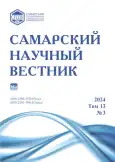Сравнительная морфобиологическая характеристика интродуцируемых на Севере образцов Hypericum perforatum разного географического происхождения
- Авторы: Эчишвили Э.Э.1, Портнягина Н.В.1, Пунегов В.В.1
-
Учреждения:
- Институт биологии Коми научного центра УрО РАН
- Выпуск: Том 13, № 3 (2024)
- Страницы: 72-80
- Раздел: Биологические науки
- URL: https://journal-vniispk.ru/2309-4370/article/view/280746
- DOI: https://doi.org/10.55355/snv2024133111
- ID: 280746
Цитировать
Полный текст
Аннотация
В статье приведены результаты четырехлетнего изучения 29 образцов зверобоя продырявленного разного географического происхождения в условиях культуры среднетаежной подзоны Республики Коми. Выявлена высокая зимостойкость растений зверобоя продырявленного первого-второго годов жизни. Отмечено значительное снижение зимостойкости большинства изучаемых образцов (до 41–68%) на третий и четвертый годы перезимовки растений. Выявлено пять зимостойких образцов – Таллин 885 и 886 (100%), Йошкар-Ола, Осло 219 и Таллин 888 (90%). Установлено, что все растения зверобоя продырявленного, выращенные рассадным способом, переходят в генеративный период на второй год жизни, регулярно цветут и плодоносят. Исследование сезонного развития зверобоя продырявленного показало, что образцы разного географического происхождения сохраняют фенологические ритмы, свойственные данному виду. Растения зверобоя продырявленного характеризуются длительными периодами цветения (39–57) и плодоношения (37–59 дней). Вегетационный период большинства образцов в зависимости от метеоусловий сезона длится 126–142 дня. Выделился один образец Таллин 885 с более коротким вегетационным периодом (100–128 дней). Приведена морфометрическая характеристика генеративного побега всех образцов у растений второго-четвертого годов жизни. Максимальные показатели флоральной части побега отмечены у образцов Барнаул, Йошкар-Ола, Сыктывкар, Таллин 885, минимальные – у сорта Солнечный и Лейпциг 379. Максимального развития растения достигали на третий год жизни. Определено суммарное содержание гиперицина и псевдогиперицина (0,04–0,06%) в растениях зверобоя продырявленного разного географического происхождения. Выявлено высокое содержание флавонолов (4,8–5,8%) в надземной сырьевой фитомассе изучаемых образцов зверобоя разного географического происхождения.
Полный текст
Открыть статью на сайте журналаОб авторах
Эльмира Элизбаровна Эчишвили
Институт биологии Коми научного центра УрО РАН
Автор, ответственный за переписку.
Email: elmira@ib.komisc.ru
кандидат биологических наук, научный сотрудник отдела Ботанический сад
Россия, г. СыктывкарНадежда Васильевна Портнягина
Институт биологии Коми научного центра УрО РАН
Email: portniagina@ib.komisc.ru
кандидат сельскохозяйственных наук, доцент, старший научный сотрудник отдела Ботанический сад
Россия, г. СыктывкарВасилий Витальевич Пунегов
Институт биологии Коми научного центра УрО РАН
Email: punegov@ib.komisc.ru
кандидат химических наук, старший научный сотрудник отдела Ботанический сад
Россия, г. СыктывкарСписок литературы
- Атлас ареалов и ресурсов лекарственных растений СССР. М.: ГУГК, 1983. 340 с.
- Мартыненко В.А., Груздев Б.И., Канев В.А. Локальные флоры таежной зоны Республики Коми. Сыктывкар, 2008. 76 с.
- Горьков В.А., Раюшкин В.А., Олейчик И.В., Чурилин Ю.Ю., Карамышева Е.И. Фитотерапия умеренных депрессий препаратами зверобоя (аналитический обзор) // Психиатрия и психофармакотерапия. 2000. Т. 2, № 6. С. 184–187.
- Kirakosyan A., Gibson D.M., Sirvent T. A comparative study of Hypericum perforatum plants as sources of hypericins and hyperforins // Journal of Herbs, Spices & Medicinal Plants. 2004. Vol. 10, iss. 4. P. 73–88. doi: 10.1300/j044v10n04_08.
- Куркин В.А., Правдивцева О.Е., Дубищев А.В., Кадацкая Д.В., Запесочная Г.Г., Жданов И.П. Исследование сырья и препаратов зверобоя // Фармация. 2005. № 3. С. 23–25.
- Soelberg J., Jørgensen L.B., Jäger A.K. Hyperforin accumulates in the translucent glands of Hypericum perforatum // Annals of Botany. 2007. Vol. 99, iss. 6. P. 1097–1100. doi: 10.1093/aob/mcm057.
- Жученко А.А. Адаптивный потенциал культурных растений (эколого-генетические основы). Кишинев: Штиинца, 1988. 766 с.
- Тюрина Е.В. Популяционные аспекты изучения исходного материала для интродукции // Ускорение интродукции растений Сибири: задачи и методы: сб. науч. тр. Новосибирск: Наука. Сиб. отд-ние, 1989. С. 34–46.
- Васфилова Е.С., Воробьева Т.А. Лекарственные и пряно-ароматические растения в условиях интродукции на Среднем Урале. Екатеринбург: УрО РАН, 2011. 245 с.
- Атлас Республики Коми по климату и гидрологии. М.: Дрофа; ДиК, 1997. 116 с.
- Майсурадзе Н.И., Киселев В.П., Черкасов О.А., Нухимовский Е.Л., Тихонова В.Л., Макарова Н.В., Угнивенко В.В. Методика исследований при интродукции лекарственных растений (Лекарственное растениеводство. Вып. 3). М.: ЦБНТИмедпром, 1984. 33 с.
- Методика фенологических наблюдений в ботанических садах СССР // Бюллетень Главного ботанического сада. Вып. 113. М.: Наука, 1979. С. 3–8.
- Беликов В.В., Точкова Т.В., Шатунова Л.В., Колесник Н.Т., Баяндина И.И. Количественное определение основных действующих веществ у видов Hypericum L. // Растительные ресурсы. 1990. Т. 26, вып. 4. С. 541–578.
- Сычев Р.Л., Пунегов В.В. Интенсификация экстракции псевдогиперицина и гиперицина из травы Hypericum perforatum L. в СВЧ поле // Новые достижения в химии и химической технологии растительного сырья: мат-лы ІIІ всерос. конф. (23–27 апреля 2007 г.). Кн. 2 / под ред. Н.Г. Базарновой, В.И. Маркина. Барнаул: Изд-во Алт. ун-та, 2007. С. 92–96.
- Зайцев Г.Н. Методика биометрических расчетов. Математическая статистика в экспериментальной ботанике. М.: Наука, 1973. 256 с.
- Эчишвили Э.Э., Портнягина Н.В., Пунегов В.В., Зайнуллина К.С. Зверобой продырявленный (Hypericum perforatum L.) в культуре на европейском Северо-Востоке / отв. ред. Г.Н. Табаленкова. Сыктывкар: Коми НЦ УрО РАН, 2014. 120 с.
- Сикура И.И., Антонюк Н.Е., Пироженко А.А., Собко В.Г., Сарычева З.А. Интродуцированные лекарственные растения / отв. ред. А.М. Гродзинский. Киев: Наук. думка, 1983. 152 с.
- Тюрина Е.В., Шохина Н.К., Гуськова И.Н. Опыт возделывания Hypericum perforatum L. в Новосибирской области // Растительные ресурсы. 1983. Т. 19, вып. 4. С. 507–512.
- Баяндина И.И. Содержание биологически активных веществ у культивируемого зверобоя продырявленного: автореф. дис. … канд. биол. наук: 03.00.05. Новосибирск, 1995. 16 с.
- Зверобоя трава // Государственная фармакопея Российской Федерации. XIV издание. Т. IV. М., 2018. С. 6074–6083.
Дополнительные файлы








